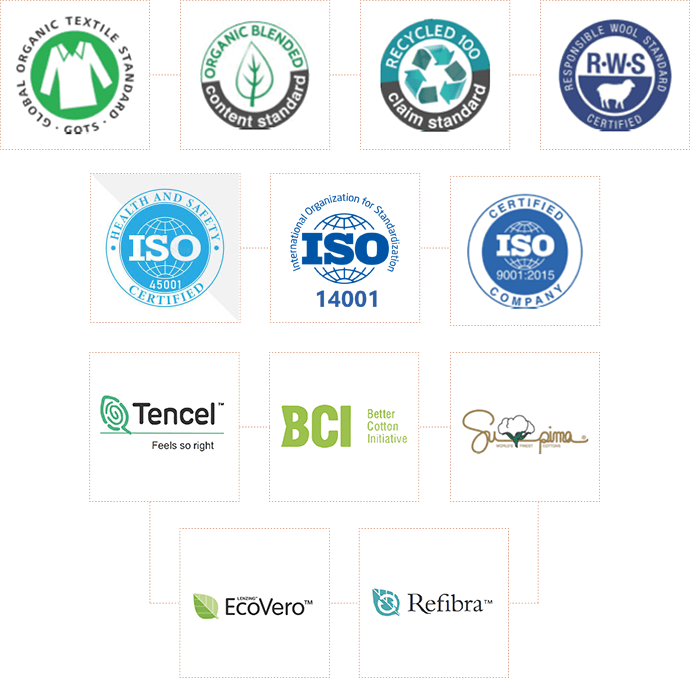Aster Companies Group is continuously expanding its investments in facilities, infrastructure, technology and digitalisation in line with its strategy of a strong internal capacity with vertical integration.
In this process, the Group has integrated the cornerstones of its sustainability strategy into its decision-making mechanisms and operational plans. Within the framework of its responsible management approach, it acts without compromising these criteria in both investment decisions and plant, machinery and technology choices, and takes the following actions while still in the investment phase:
- Choosing machines with the lowest environmental impact and low water and energy consumption,
- Supporting processes with the most advanced water and heat recovery modules currently available,
- Traceable, fast and accurate process management with digital solutions using full automation and artificial intelligence,
- Ensuring the integration of existing processes with renewable energy use, rainwater collection and treatment systems, wastewater recovery solutions.
Aster Textile measures and verifies the environmental impacts of its operations, both for its own factories and for the facilities in its supply chain, based on international standards and certifications. It continuously strives to improve its management systems by taking a holistic approach to economic, social and environmental sustainability. Aster has ISO 9001, ISO 45001 and ISO 14001 certifications.
Sustainable Products
Aster Textile offers its customers innovative solutions from design to production through R&D and P&D studies and investments that will increase product quality, durability, reuse and recycling capabilities and thus increase the added value of the product and reduce its environmental impact.
In addition, it continuously improves its certification processes and collaborations to ensure that its raw materials are transparent and traceable from the source to the final product. The company integrates raw material, fabric and finished product tracking systems that enable the use of new raw materials such as Regenerative Cotton into its facilities and ERP systems.
Aster Textile continues to develop its collaborations locally and globally as part of the continuation of the Aster Second Life˝ Project, in which it provides a second chance of life to waste materials. This enables the company to reuse the waste from its operations in the production of yarns, fabrics and accessories, and to continuously improve the quality and diversity of the resulting material.
Policies
Information Technologies
Secure and transparent Information Security Management System...
Aster Corporate Group is committed to protecting its information assets and managing these assets to serve its corporate mission, vision and strategies. Aster effectively manages and continuously improves its reliable and transparent Information Security Management System (ISMS) to ensure internal and external customer satisfaction, pursuant to its ISMS Policy.
The core principles of Aster’s ISMS Policy include:
- Awareness of information assets, analysing and identifying risks, and taking appropriate measures;
- Protecting the information assets of Aster against any and all threats that may arise either internally or externally, intentionally or unintentionally and ensuring the confidentiality, integrity and accessibility of information as required;
- Complying with all applicable laws, rules, regulations, directives and procedures for which Aster is responsible;
- Closely monitoring technological innovations and developments in the field of ISMS, ensuring continuous improvement of the ISMS, and reviewing at regular intervals;
- Maintaining the competence for rapid intervention to any information security events that may occur and minimising the impact of the event.
In the coming year, Aster Textile plans to focus more on production innovation in line with changing trends in information technology. This effort aims to boost Aster’s competitive advantage in this critical area. The impacts of these improvements and upgrades on the natural environment are the main criteria to be considered. Aster Textile conducts various efforts in key areas such as paper use, energy consumption with virtualisation technologies and cloud technologies. Aster targets scaling IT operations and IT designs in accordance with “Green IT” principles and the reduction of energy consumption to reduce energy costs. The Information Technologies team sees technology and science as important tools to bequeath a more liveable environment to future generations with less negative impact to Turkey and the world.
Innovation and R&D
Closely following innovative technologies...
Aster Textile closely follows developments in technology and innovation. Faced with high sample development costs, the Group is taking advantage of new technologies. Traditional methods waste material and time in the sample production process, increasing the environmental impact. For this reason, Aster uses the leading 3D design software CLO 3D and Browzwear to design an unlimited number of samples in minimum time and cost, making a positive contribution to the Group’s sustainability efforts.
Using these 3D simulation platforms, Aster Textile brings its collections and pre-production sample processes to its digital showroom. Avatars created specifically for Aster’s partners greatly reduce the need to send physical samples. As a result, less raw materials, energy and water are used, and the carbon footprint is greatly reduced by eliminating packaging materials used in the sampling and shipping processes.
Investments in DigiEye and DigiView enable Aster Textile to minimise its environmental impact related to sample shipping and the relevant costs. Thanks to these solutions, colour approval processes can be completed within 24 hours without the need for physical package shipment by air. This represents a significant time saving, much shorter than the minimum of seven days required for conventional methods. This method reduces the carbon footprint and gives the company increased agility in the sales process and a significant competitive advantage.
Aster Textile is implementing another important innovative initiative, the digital transformation project, to access realtime quality, productivity and production information during the production process. General operation of the system called Simultaneous Data Collection System is as follows: All data collected in the field via tablets is updated every 30 seconds and published on large screens (dashboards) in the production area at specified periods. In this way, the quality and efficiency of production is monitored simultaneously by field teams and management is ensured through rapid actions.
ASTER DESIGN DEPOT – ASTER DIGITAL DESIGN LIBRARY
Aster Digital Design Library systematically and securely repositions necessary images and information about Aster collections on the cloud by integrating with ERP, enabling online, real-time collaboration with customers in the product development processes. Setting an example of digital transformation efforts in the ready-made and fashion industry, this application not only creates speed and cost advantages in sales, but also reduces the carbon footprint.
Certificates
- ISO 45001 Occupational Health and Safety Management System
- ISO 14001 Environmental Management System
- ISO 9001 Quality Management System
- Global Organic Textile Standard (GOTS)
- Recycled Claim Standard (RCS)
- Recycled Blended Claim Standard
- Organic 100 Content Standard (OCS)
- Organic Blended Content Standard
- Responsible Wool (RWS)
- Tencel
- Better Cotton Initiative (BCI)
- Supima – World’s Finest Cottons
- Lenzing™ EcoVero™
- Refibra™

Product Tracebility
At Aster Textile, in line with our sustainability strategy and principle of transparency, we continue to work tirelessly to make the supply chain map of all our products fully traceable.
In this context, in addition to the GOTS, OCS, GRS, RCS, and RegenAgri certifications that we hold for organic and recycled products and that are valid across all our facilities, we are also monitoring and integrating systems to track all the materials in our supply chain. Through this effort, we aim to create digital passports for our products, enabling us to measure and improve their environmental impact more accurately. With the traceability of our products, we can transparently present the source, production conditions, and environmental impacts of each material to the end user.
As part of this initiative, we are conducting Life Cycle Assessment (LCA) studies through various collaborations and modern technologies. Digital traceability solutions such as Textile Genesis and TrusTrace enhance the transparency of our supply chain and contribute to our sustainability goals. The integration of these systems not only supports environmental goals but also allows us to fulfill our social responsibilities. By ensuring the traceability of suppliers, production processes, and materials at every stage, we maintain high transparency regarding worker rights, occupational safety, and social standards.
At the same time, we work closely with our suppliers, educating them on these digital traceability systems and facilitating their integration. In doing so, we continuously improve the transparency and sustainability performance of all our processes.
The efforts and investments we make under the traceability framework not only reduce environmental impacts but also make our business processes more efficient. As Aster Textile, we remain committed to contributing to sustainability, setting industry standards, and serving as a role model in the fashion world of the future. While fulfilling both our environmental and social responsibilities, we are determined to lead the way in shaping the technologies of tomorrow.
